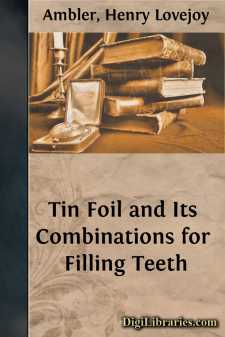Categories
- Antiques & Collectibles 13
- Architecture 36
- Art 48
- Bibles 22
- Biography & Autobiography 813
- Body, Mind & Spirit 142
- Business & Economics 28
- Children's Books 15
- Children's Fiction 12
- Computers 4
- Cooking 94
- Crafts & Hobbies 4
- Drama 346
- Education 46
- Family & Relationships 57
- Fiction 11828
- Games 19
- Gardening 17
- Health & Fitness 34
- History 1377
- House & Home 1
- Humor 147
- Juvenile Fiction 1873
- Juvenile Nonfiction 202
- Language Arts & Disciplines 88
- Law 16
- Literary Collections 686
- Literary Criticism 179
- Mathematics 13
- Medical 41
- Music 40
- Nature 179
- Non-Classifiable 1768
- Performing Arts 7
- Periodicals 1453
- Philosophy 64
- Photography 2
- Poetry 896
- Political Science 203
- Psychology 42
- Reference 154
- Religion 513
- Science 126
- Self-Help 84
- Social Science 81
- Sports & Recreation 34
- Study Aids 3
- Technology & Engineering 59
- Transportation 23
- Travel 463
- True Crime 29
Tin Foil and Its Combinations for Filling Teeth
Categories:
Description:
Excerpt
PREFACE.
Believing that sufficient and well-deserved prominence was not being given to the use of tin foil and its combinations, the author decided to present a brief historical résumé of the subject, together with such practical information as he possesses, before the profession in order that it may have the satisfaction of saving more teeth, since that is the pre-eminent function of the modern dentist. One object is to meet the demand for information in regard to the properties and uses of tin foil; this information has been sought to be given in the simplest form consistent with scientific accuracy. The present use of tin is a case of the "survival of the fittest," because tin was used for filling teeth more than one hundred years ago. There is not a large amount of literature upon the subject, and no single text-book has treated the matter fully enough to answer the needs of both teacher and pupil. It is difficult for the student to collect and harmonize from the many different sources just the kind and amount of information required for his special use. Perhaps this work will be of assistance to scientific students and practical operators in the art of using tin foil, including all who wish in compact form an explanation of the facts and principles upon which the art is based. A good method to arouse in students an interest in the use of tin foil is to have them use it in operative technics, which is becoming an effective adjunct in every dental college. By this means a great factor will be brought to bear, and the result will be that hundreds of graduates every year will begin practice better qualified to save teeth than if they had not known whatever may be learned about this material. At the University of Pennsylvania, Department of Dentistry, session 1896-97, out of the total number of fillings made in the clinical department (fractions omitted) 55 per cent. were gold, 15 per cent. tin, 10 per cent. amalgam. This shows that tin has some very strong friends in the persons of Professors Darby and Kirk.
The historical sketch of the development of the subject is arranged in chronological order, and is given partly to show that some old ideas and methods were good, and some obviously incorrect when viewed in the light of more recent developments. Part of the history will be new to the oldest members of the profession, and the younger ones will certainly read it with interest. The work has been brought up to date by considering all the properties and methods available. More names, good opinions, and dates could have been given, but the writer believes that what is herein presented is enough to thoroughly substantiate his own opinions, experiments, and practical applications. Some of the illustrations have been made especially for this work; the others have been obtained through the courtesy of the owners.
"Let not the foggy doctrine of the superiority of gold in all cases act on progress as the old medieval superstitions acted on astronomy, physiology, zoology....


